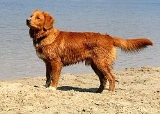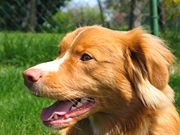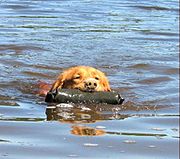
Nova Scotia Duck-Tolling Retriever
Encyclopedia
The Nova Scotia Duck-Tolling Retriever, or Toller for short, is a medium sized breed
of gundog bred primarily for hunting. The dog originated in southwestern Nova Scotia
, Canada. It is the smallest of the retrievers.
within gunshot range, called "tolling". The hunter stays hidden in a blind
and sends the dog out to romp and play near the water, usually by tossing a ball or stick to be retrieved. Appearing similar to a fox, the dog's unusual activity and white markings pique the curiosity of ducks and geese, who swim over to investigate.
When the birds are close, the hunter calls the dog back to the blind, then rises, putting the birds to flight, allowing him a shot. The Toller then retrieves any downed birds. They are particularly suited for retrieving in cold water climates because of their water-repellent double coat.
in Yarmouth County, Nova Scotia, around the beginning of the 19th century to toll waterfowl. Its exact origins are not known but it appears that some possibly spaniel and setter-type dogs, retriever-type dogs, and farm collie may have gone into the mix. It may share origins with the smaller Kooikerhondje, which has a similar method of work.
The Toller was officially admitted to the Canadian Kennel Club
in 1945. Some consider that the breed came of age in 1980, when two Nova Scotia Duck-Tolling Retrievers were awarded Best in Show at championship events that included many breeds. On June 11, 2001, it was approved for admission into the Miscellaneous Class of the American Kennel Club
and was granted full recognition into the Sporting Group on July 1, 2003.
The Toller was made the provincial dog of Nova Scotia in 1995.
 The breed is often mistaken for small Golden Retriever
The breed is often mistaken for small Golden Retriever
s, but the Toller is more active, both physically and mentally. According to the breed standard
s, the Toller should be athletic, well-muscled, compact, medium boned, balanced and powerful. The chest is deep. Conformation judges require Tollers to be capable of tolling, and physical faults that inhibit working ability are heavily penalized. They should be of moderate build—a lack of substance or a heavy build are penalized by judges, as both detract from the type and athleticism. The legs are sturdy and solid. Tollers have webbed feet.
Those who breed Tollers for conformation show
s consider the head (clean cut, slightly wedge-shaped) to be an important feature, and believe it should resemble that of a fox
and must never be blocky like that of a Golden Retriever
. The ears are triangular and set high and well back from the skull. The tail is well feathered and held jauntily when the dog is excited or moving.
Color is any shade of red, ranging from a golden red through dark coppery red, with lighter featherings on the underside of the tail, pantaloons, and body. Even the lighter shades of golden red are deeply pigmented and rich in color. The Toller should not be buff or brown. Although very rare, there are chocolate/liver brown Duck Tollers.
The Toller has usually at least one of the following white markings: tip of tail, feet (not extending above the pastern
s), chest, and blaze. Lack of white is not a fault. Dogs with white on the shoulders, around ears, back of neck, or across back or flanks, or with silvery, grey or black areas in coat are disqualified from conformation shows.
The Toller was bred to retrieve from icy waters and must have a water-repellent double coat of medium length and softness, and a soft dense undercoat. The coat may have a slight wave on the back, but is otherwise straight. Some winter coats may form a long loose curl at the throat. Featherings are soft and moderate in length. The hair on the muzzle is short and fine. Seasonal shedding is to be expected.
, and weigh 40–55 lb (18.1–24.9 kg), with females being slightly shorter and lighter. Tollers are always a medium-sized breed, never large; however, there has been a trend towards larger dogs in recent years.
Tollers should be slightly longer than tall (a ratio of approximately 10 to 9). However, they should not appear long-backed.
Duck Tollers are working animals and are happiest when they have a job to do. Physical stimulation should be provided for these dogs each day, as they may become destructive when they are not exercised enough or left alone for too long. They have a strong retrieving drive, intense birdiness, endurance and a love for water. {Citation needed|date=August 2011}}

s are known to occur in the breed. This is sometimes blamed on a relatively small gene pool
. The Toller's hereditary diseases include Addison's disease
, progressive retinal atrophy
, and hip dysplasia.
The average life span is about 12–14 years.
Dog breed
Dog breeds are groups of closely related and visibly similar domestic dogs, which are all of the subspecies Canis lupus familiaris, having characteristic traits that are selected and maintained by humans, bred from a known foundation stock....
of gundog bred primarily for hunting. The dog originated in southwestern Nova Scotia
Nova Scotia
Nova Scotia is one of Canada's three Maritime provinces and is the most populous province in Atlantic Canada. The name of the province is Latin for "New Scotland," but "Nova Scotia" is the recognized, English-language name of the province. The provincial capital is Halifax. Nova Scotia is the...
, Canada. It is the smallest of the retrievers.
Use in hunting
Tollers are named for their ability to entice or lure waterfowlWaterfowl
Waterfowl are certain wildfowl of the order Anseriformes, especially members of the family Anatidae, which includes ducks, geese, and swans....
within gunshot range, called "tolling". The hunter stays hidden in a blind
Hunting blind
A hunting blind is a cover device for hunters, designed to reduce the chance of detection; ground blinds are an alternative to the traditional Treestand, movements in a well-designed ground blind can virtually be undetectable by the game....
and sends the dog out to romp and play near the water, usually by tossing a ball or stick to be retrieved. Appearing similar to a fox, the dog's unusual activity and white markings pique the curiosity of ducks and geese, who swim over to investigate.
When the birds are close, the hunter calls the dog back to the blind, then rises, putting the birds to flight, allowing him a shot. The Toller then retrieves any downed birds. They are particularly suited for retrieving in cold water climates because of their water-repellent double coat.
History
The breed was developed in the community of Little River HarbourLittle River Harbour, Nova Scotia
Little River Harbour is a community in the Canadian province of Nova Scotia, located in the Yarmouth Municipal District in Yarmouth County.It is the birthplace of the Nova Scotia Duck-Tolling Retriever....
in Yarmouth County, Nova Scotia, around the beginning of the 19th century to toll waterfowl. Its exact origins are not known but it appears that some possibly spaniel and setter-type dogs, retriever-type dogs, and farm collie may have gone into the mix. It may share origins with the smaller Kooikerhondje, which has a similar method of work.
The Toller was officially admitted to the Canadian Kennel Club
Canadian Kennel Club
The Canadian Kennel Club is the primary registry body for purebred dog pedigrees in Canada. Beyond maintaining the pedigree registry, the C.K.C...
in 1945. Some consider that the breed came of age in 1980, when two Nova Scotia Duck-Tolling Retrievers were awarded Best in Show at championship events that included many breeds. On June 11, 2001, it was approved for admission into the Miscellaneous Class of the American Kennel Club
American Kennel Club
The American Kennel Club is a registry of purebred dog pedigrees in the United States. Beyond maintaining its pedigree registry, this kennel club also promotes and sanctions events for purebred dogs, including the Westminster Kennel Club Dog Show, an annual event which predates the official...
and was granted full recognition into the Sporting Group on July 1, 2003.
The Toller was made the provincial dog of Nova Scotia in 1995.
Appearance

Golden Retriever
The Golden Retriever is a medium-sized breed of dog. They were historically developed as gundogs to retrieve shot waterfowl such as ducks and upland game birds during hunting and shooting parties. As such, they were bred to have a soft mouth to retrieve game undamaged and have an instinctive love...
s, but the Toller is more active, both physically and mentally. According to the breed standard
Breed standard
A breed standard in animal fancy and animal husbandry is a set of guidelines which is used to ensure that the animals produced by a breeder or breeding facility conform to the specifics of the breed....
s, the Toller should be athletic, well-muscled, compact, medium boned, balanced and powerful. The chest is deep. Conformation judges require Tollers to be capable of tolling, and physical faults that inhibit working ability are heavily penalized. They should be of moderate build—a lack of substance or a heavy build are penalized by judges, as both detract from the type and athleticism. The legs are sturdy and solid. Tollers have webbed feet.
Those who breed Tollers for conformation show
Conformation show
Conformation shows, also referred to as breed shows, are a kind of dog show in which a judge familiar with a specific dog breed evaluates individual purebred dogs for how well the dogs conform to the established breed type for their breed, as described in a breed's individual breed standard.A...
s consider the head (clean cut, slightly wedge-shaped) to be an important feature, and believe it should resemble that of a fox
Red Fox
The red fox is the largest of the true foxes, as well as being the most geographically spread member of the Carnivora, being distributed across the entire northern hemisphere from the Arctic Circle to North Africa, Central America, and the steppes of Asia...
and must never be blocky like that of a Golden Retriever
Golden Retriever
The Golden Retriever is a medium-sized breed of dog. They were historically developed as gundogs to retrieve shot waterfowl such as ducks and upland game birds during hunting and shooting parties. As such, they were bred to have a soft mouth to retrieve game undamaged and have an instinctive love...
. The ears are triangular and set high and well back from the skull. The tail is well feathered and held jauntily when the dog is excited or moving.
Color is any shade of red, ranging from a golden red through dark coppery red, with lighter featherings on the underside of the tail, pantaloons, and body. Even the lighter shades of golden red are deeply pigmented and rich in color. The Toller should not be buff or brown. Although very rare, there are chocolate/liver brown Duck Tollers.
The Toller has usually at least one of the following white markings: tip of tail, feet (not extending above the pastern
Pastern
The pastern is a part of the leg of a horse between the fetlock and the top of the hoof. It incorporates the long pastern bone and the short pastern bone , which are held together by two sets of paired ligaments to form the pastern joint...
s), chest, and blaze. Lack of white is not a fault. Dogs with white on the shoulders, around ears, back of neck, or across back or flanks, or with silvery, grey or black areas in coat are disqualified from conformation shows.
The Toller was bred to retrieve from icy waters and must have a water-repellent double coat of medium length and softness, and a soft dense undercoat. The coat may have a slight wave on the back, but is otherwise straight. Some winter coats may form a long loose curl at the throat. Featherings are soft and moderate in length. The hair on the muzzle is short and fine. Seasonal shedding is to be expected.
Size and proportions
Tollers are the smallest of all the retriever breeds. They range in height from 17–21 in (43.2–53.3 cm) at the withersWithers
The withers is the ridge between the shoulder blades of a four-legged animal. In many species it is the tallest point of the body, and in horses and dogs it is the standard place to measure the animal's height .-Horses:The withers in horses are formed by the dorsal spinal processes of roughly the...
, and weigh 40–55 lb (18.1–24.9 kg), with females being slightly shorter and lighter. Tollers are always a medium-sized breed, never large; however, there has been a trend towards larger dogs in recent years.
Tollers should be slightly longer than tall (a ratio of approximately 10 to 9). However, they should not appear long-backed.
Temperament
Nova Scotia Duck-Tolling Retrievers are known to be very intelligent, alert, high-energy dogs. They tend to be very affectionate and outgoing animals with family members and are known for being very patient with children. Some dogs may be reserved in new situations but they are not shy. They excel at many types of competitions, such as agility and obedience.Duck Tollers are working animals and are happiest when they have a job to do. Physical stimulation should be provided for these dogs each day, as they may become destructive when they are not exercised enough or left alone for too long. They have a strong retrieving drive, intense birdiness, endurance and a love for water. {Citation needed|date=August 2011}}

Health
Tollers are generally hearty. However, like almost all dog breeds, certain genetic disorderGenetic disorder
A genetic disorder is an illness caused by abnormalities in genes or chromosomes, especially a condition that is present from before birth. Most genetic disorders are quite rare and affect one person in every several thousands or millions....
s are known to occur in the breed. This is sometimes blamed on a relatively small gene pool
Gene pool
In population genetics, a gene pool is the complete set of unique alleles in a species or population.- Description :A large gene pool indicates extensive genetic diversity, which is associated with robust populations that can survive bouts of intense selection...
. The Toller's hereditary diseases include Addison's disease
Addison's disease in canines
Addison's disease in canines refers to hypoadrenocorticism, or Addison's disease, when it occurs in canines. The first case of Addison’s disease in dogs was recorded in 1953, over 100 years after it was described in humans by Thomas Addison.-Description:...
, progressive retinal atrophy
Progressive retinal atrophy
Progressive retinal atrophy is a group of genetic diseases seen in certain breeds of dogs and, more rarely, cats. Similar to retinitis pigmentosa in humans, it is characterized by the bilateral degeneration of the retina, causing progressive vision loss culminating in blindness...
, and hip dysplasia.
The average life span is about 12–14 years.

